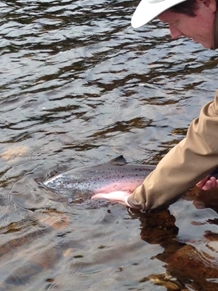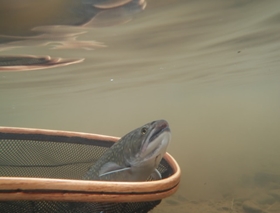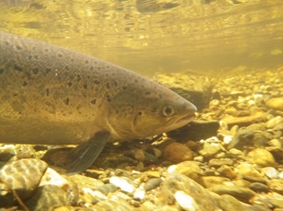How to properly catch and release Atlantic salmon
 In the Gulf Region, mandatory catch and release of large Atlantic salmon has been in effect since 1984. It was also applied to small salmon (grilse) since 2015, following low returns observed in recent years.
In the Gulf Region, mandatory catch and release of large Atlantic salmon has been in effect since 1984. It was also applied to small salmon (grilse) since 2015, following low returns observed in recent years.
Releasing in a way that minimizes harm to the fish is required by law. But, it’s not only a matter of law. By improving the survival rate of the fish you release, you are also doing your part for the recovery of Atlantic salmon.
Here are a few simple tips to follow:
- Use barbless (or pinched barbs) flies. This will reduce the time needed to handle the fish and get the hook out. As an added benefit, barbless flies will also help release the juvenile salmon (parrs) or other small fish that you may hook.
- Once you hook a salmon, minimize as much as possible the duration of the fight. You are going to release it; you don’t have to fear losing it. Do not exhaust a fish as it may not recover. Post-angling mortality can occur several hours after the fish is released. Post-angling mortality increases significantly with water temperature exceeding 20°C therefore minimize angling activities at these higher temperatures.
- If you use a net to land the fish, use a net with rubber mesh, or at least avoid using any net with knotted mesh, that can damage the scales, gills or eyes of the fish. Make sure to wet your hands before tailing or handling the fish. Never grab a fish by the gills.
- Minimize the time the fish spends out of the water. Fish suffocate rapidly when out of the water.
- Before releasing the fish, revive it by holding it underwater facing the current, one hand gently holding the tail and the other hand supporting the underside. Be gentle. Do not ‘pump’ the fish in the current. When you feel the fish has regained strength and starts swimming again vigorously in your hands, let it go. Time for reviving varies depending on the duration of the fight, the size of the fish, and especially water temperature. The movements of the fish will be your best indicator.
For photos and selfies:
- If you take a picture with the fish out of the water, only remove it from the water no more than a few seconds, the time you need to actually take the picture. When you are alone it is best to leave the fish in the water while holding its tail to take your photo or selfie.
Useful links
- Atlantic Salmon Federation live release video tutorial
https://www.youtube.com/watch?v=8ztoZGBoxwg&feature=youtu.be - Live release - Best Practices (Miramichi Salmon Association)
http://www.miramichisalmon.ca/proper-techniques-for-live-release-of-atlantic-salmon/


Catch and release fishing can be an opportunity to take great pictures,
without even having to remove the fish from the water